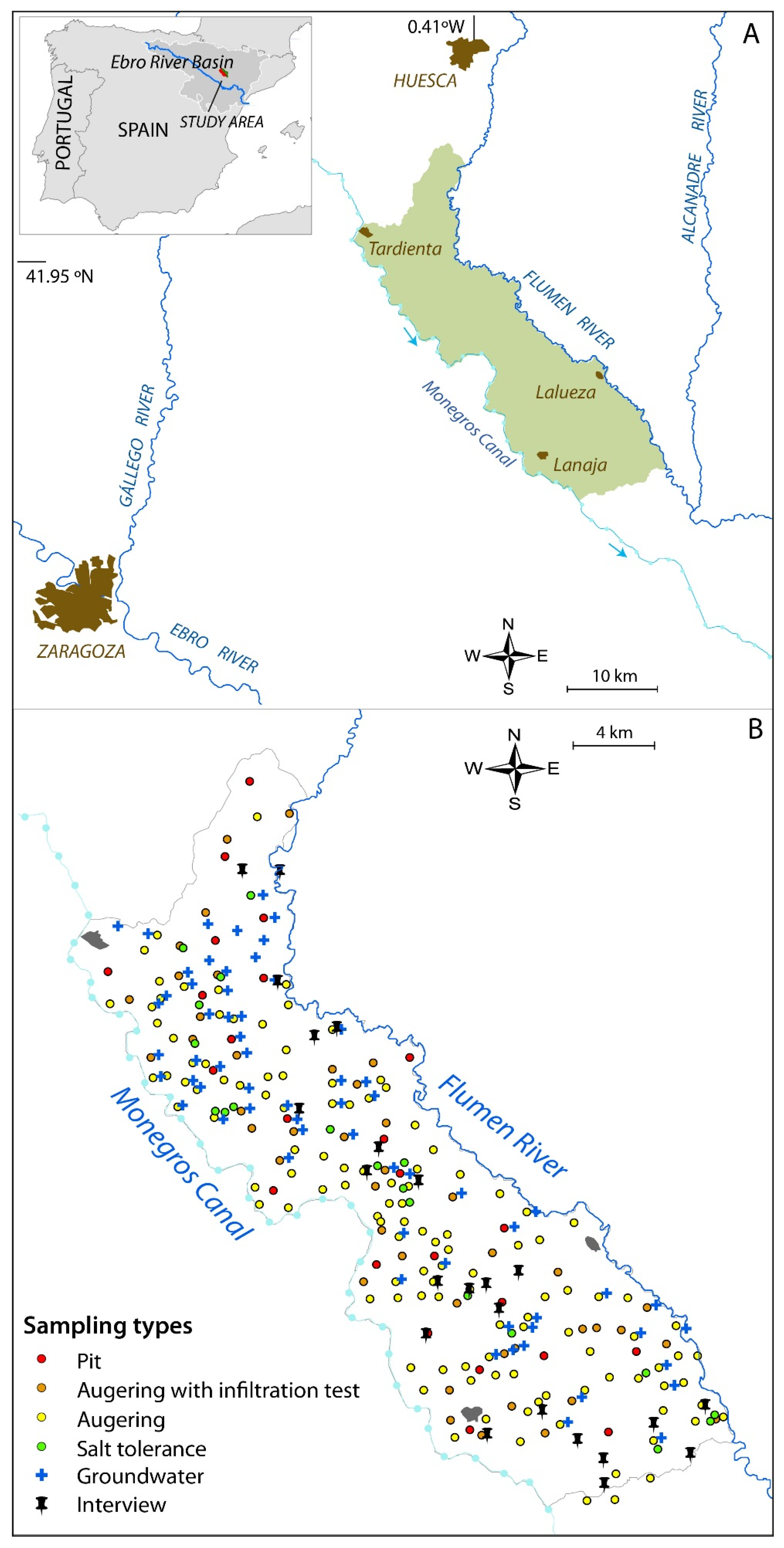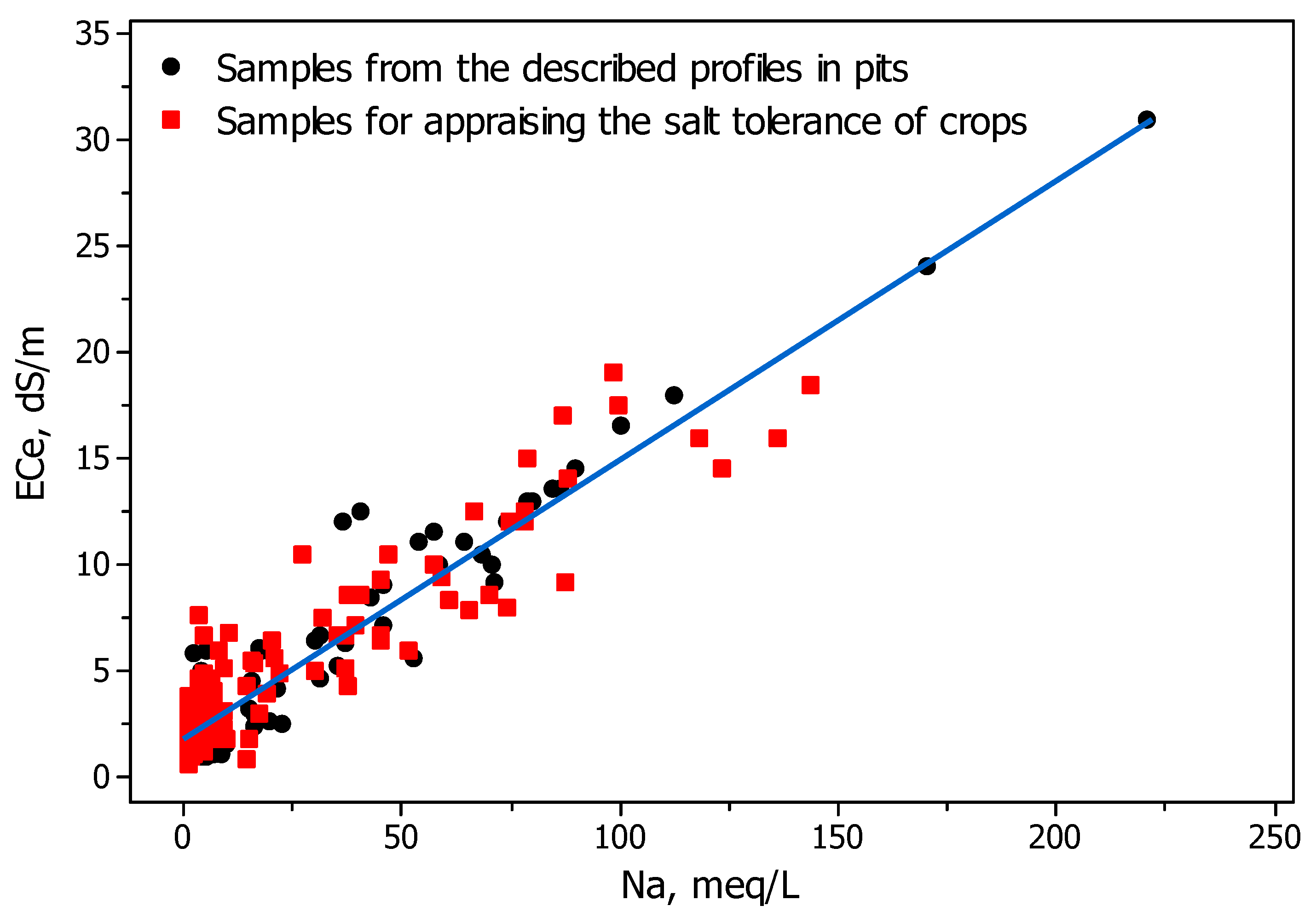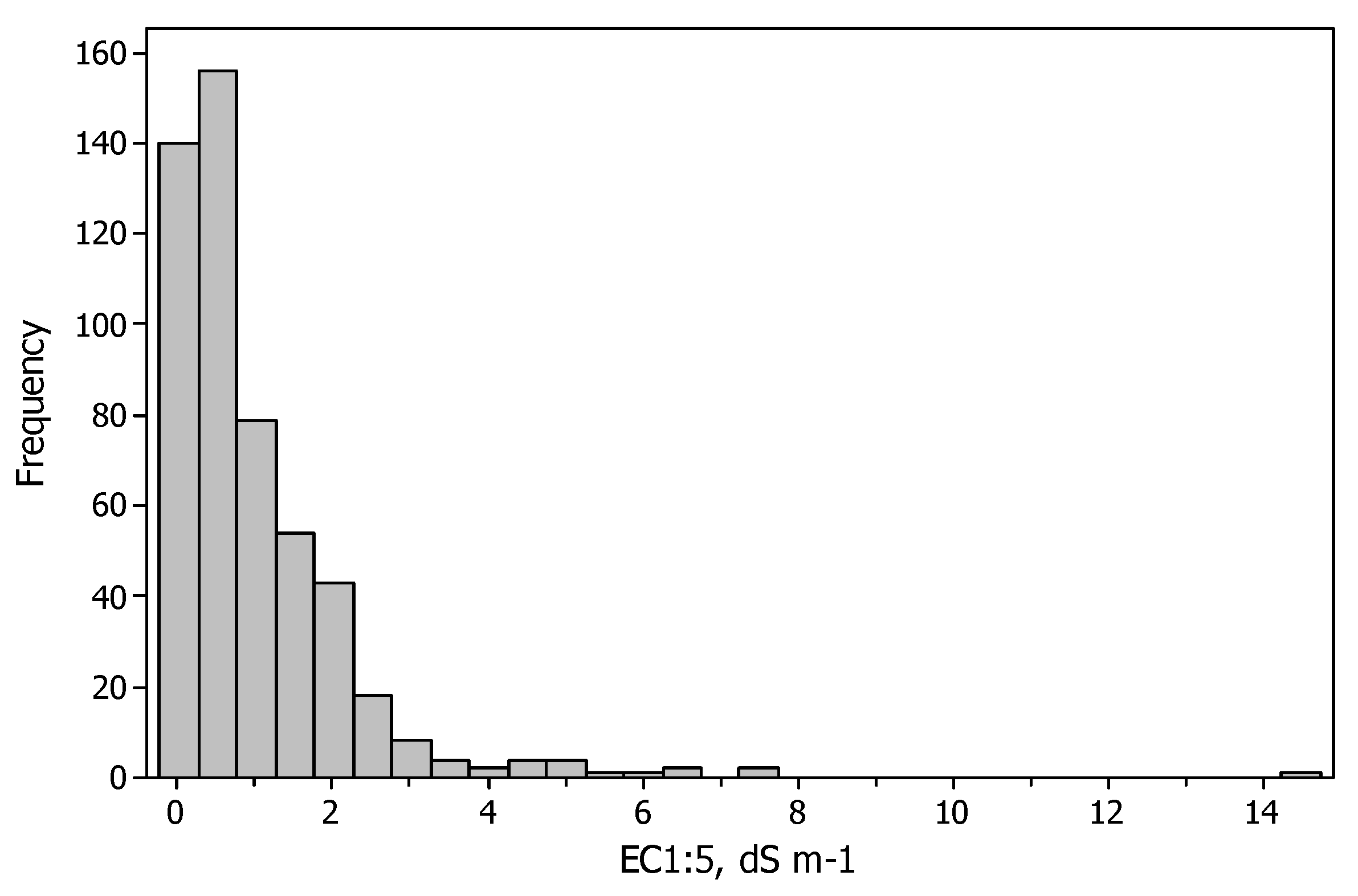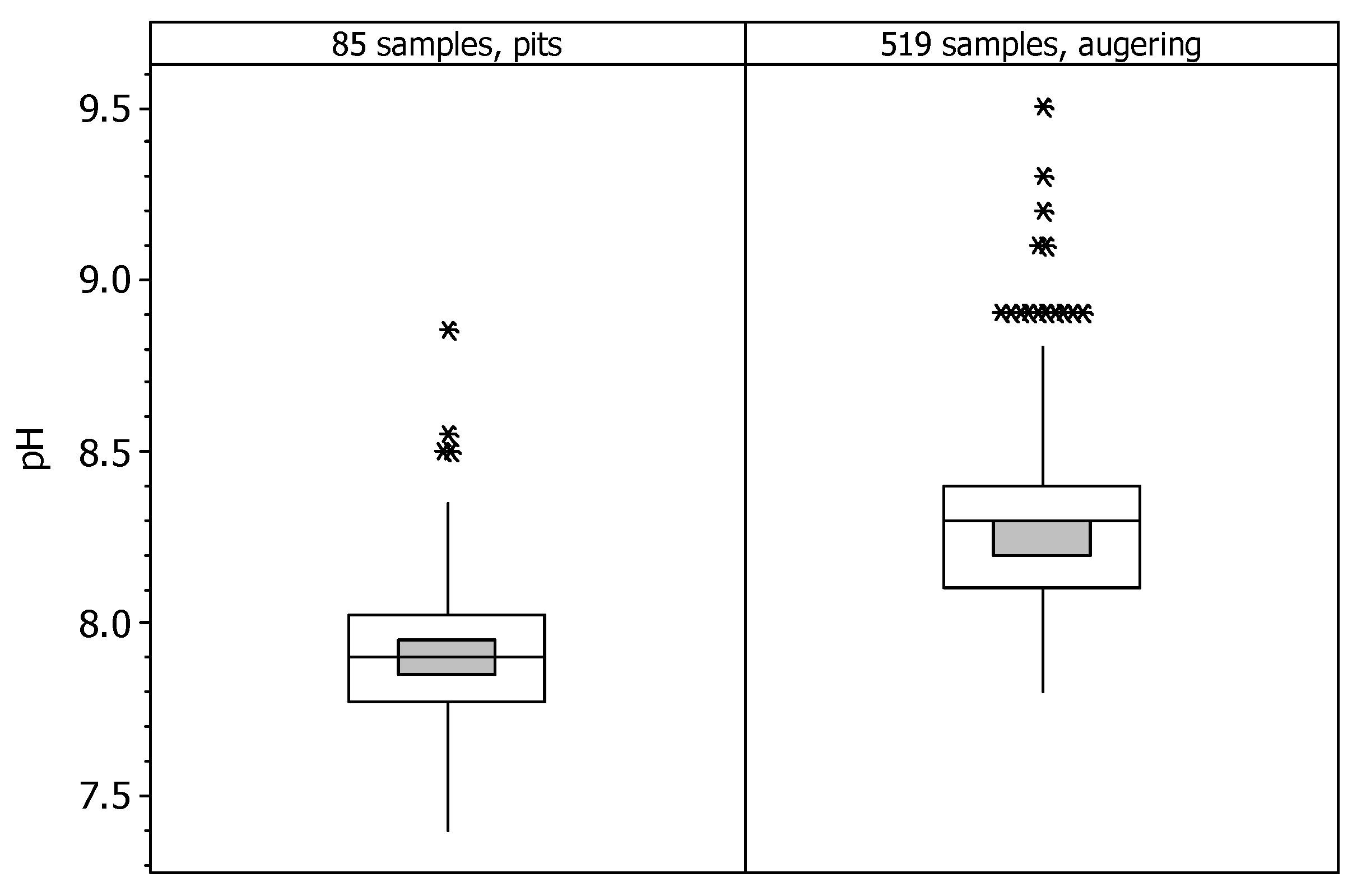A Heritage Agronomic Study as a Database for Monitoring the Soil Salinity of an Irrigated District in NE Spain
Abstract
:1. Introduction
2. The Context of the 1975 Report
3. Temporal and Geographical Setting
4. Subjects Addressed by the Report
5. Scrutiny of the Material and Methods in the IRYDA Report
5.1. Soil Salinity and the Electrical Conductivity of the Soil
5.2. Soil Analysis Methods in 1975
5.3. Soil Salinity Information Obtained from ECe Determinations
5.3.1. The Salinity in the Profiles Described in Pits
5.3.2. Salinity in the Sampling for Salinity Tolerance of Crops
5.3.3. Comparing ECe and Na+ between the Two Batches of Samples
5.4. The Stock of Soluble Salts in the Soil
5.5. Location of the Soil Sampling Sites
6. Conclusions
Author Contributions
Funding
Data Availability Statement
Acknowledgments
Conflicts of Interest
Abbreviations
References
- Hopmans, J.W.; Qureshi, A.S.; Kisekka, I.; Munns, R.; Grattan, S.R.; Rengasamy, P.; Ben-Gal, A.; Assouline, S.; Javaux, M.; Minhas, P.S.; et al. Critical knowledge gaps and research priorities in global soil salinity. Adv. Agron. 2021, 169, 1–191. [Google Scholar] [CrossRef]
- Stavi, I.; Thevs, N.; Priori, S. Soil salinity and sodicity in drylands: A review of causes, effects, monitoring, and restoration measures. Front. Environ. Sci. 2021, 9, 712831. [Google Scholar] [CrossRef]
- FAO. Global Map of Salt-Affected Soils; GSASmap v1.0.0; FAO: Rome, Italy, 2021; Available online: https://www.fao.org/soils-portal/data-hub/soil-maps-and-databases/global-map-of-salt-affected-soils/en/ (accessed on 22 December 2021).
- Daliakopoulos, I.N.; Tsanis, I.K.; Koutroulis, A.; Kourgialas, N.N.; Varouchakis, A.E.; Karatzas, G.P.; Ritsema, C.J. The threat of soil salinity: A European scale review. Sci. Total Environ. 2016, 573, 727–739. [Google Scholar] [CrossRef]
- Ayers, A.D.; Vázquez, A.; De la Rubia, J.; Blasco, F.; Samplón, S. Saline and sodic soils of Spain. Soil Sci. 1960, 90, 133–138. [Google Scholar] [CrossRef]
- Cervera-Álvarez, R. Los suelos salinos de la Depresión del Ebro. Boletín Asoc. Nac. Ing. Agrónomos 1966, 167, 193–199. [Google Scholar]
- Grande-Covián, R. Las Marismas del Guadalquivir y su Rescate; Colección Estudios 5 (29); Ministerio de Agricultura, Instituto Nacional de Colonización: Madrid, Spain, 1967; 64p. [Google Scholar]
- Zekri, S.; Albisu, L.M. Economic impact of soil salinity in agriculture. A case study of Bardenas area, Spain. Agric. Syst. 1993, 41, 369–386. [Google Scholar] [CrossRef]
- Calvo, E.; Feijóo, M.L.; Mema, M.; Albiac, J. La influencia de la Política Agrícola Común en la zona de Regadío Flumen-Monegros. Estud. Econ. Appl. 1999, 13, 5–22. [Google Scholar]
- Castañeda, C.; Herrero, J.; Latorre, B. The vanishing legacy of soil salinity data from irrigated districts: A case study from Spain and a call for action. Adv. Agron. 2020, 161, 325–355. [Google Scholar] [CrossRef]
- Berbel, J.; Expósito, A.; Gutiérrez-Martín, C.; Mateos, L. Effects of the irrigation modernization in Spain 2002–2015. Water Resour. Manag. 2019, 33, 1835–1849. [Google Scholar] [CrossRef]
- Filippi, P.; Cattle, S.R.; Bishop, T.F.A.; Pringle, M.J.; Jones, E.J. Monitoring changes in soil salinity and sodicity to depth, at a decadal scale, in a semiarid irrigated region of Australia. Soil Res. 2018, 56, 696–711. [Google Scholar] [CrossRef]
- Ivushkin, K.; Bartholomeus, H.; Bregt, A.; Pulatov, A.; Kempen, B.; De Sousa, L. Global mapping of soil salinity change. Remote Sens. Environ. 2019, 231, 111260. [Google Scholar] [CrossRef]
- Hassani, A.; Azapagic, A.; Shokri, N. Predicting long-term dynamics of soil salinity and sodicity on a global scale. Proc. Natl. Acad. Sci. USA 2020, 117, 33017–33027. [Google Scholar] [CrossRef]
- Cruz-Lapazarán, J. El fundamento del concurso de material de nivelación de Tardienta. Rev. Confed. Sind. Hidrográfica Ebro 1927, 1, 8–9. [Google Scholar]
- Casterad, M.A.; Herrero, J. Irrivol: A method to estimate the yearly and monthly water applied in an irrigation district. Water Resour. Res. 1998, 34, 3045–3049. [Google Scholar] [CrossRef]
- Nogués, J.; Herrero, J.; Rodríguez-Ochoa, R.; Boixadera, J. Land evaluation in a salt-affected irrigated district using an index of productive potential. Environ. Manag. 2000, 25, 143–152. [Google Scholar] [CrossRef] [PubMed]
- Sumner, M.E. Soil testing and plant analysis: Building a future on our legacy. Commun. Soil Sci. Plant Anal. 2006, 37, 2277–2287. [Google Scholar] [CrossRef]
- De Bruyn, L.L.; Jenkins, A.; Samson-Liebig, S. Lessons learnt: Sharing soil knowledge to improve land management and sustainable soil use. Soil Sci. Soc. Am. J. 2017, 81, 427–443. [Google Scholar] [CrossRef]
- Minai, J.O.; Schulze, D.G.; Libohova, Z. Renewal of archival legacy soil data: A case study of the Busia Area, Kenya. Front. Soil Sci. 2021; in press. [Google Scholar] [CrossRef]
- Hawkins, S.J.; Firth, L.B.; McHugh, M.; Poloczanska, E.S.; Herbert, R.J.H.; Burrows, M.T.; Kendall, M.A.; Moore, P.J.; Thompson, R.C.; Jenkins, S.R.; et al. Data rescue and re-use: Recycling old information to address new policy concerns. Mar. Policy 2013, 42, 91–98. [Google Scholar] [CrossRef]
- Schröder, J.J.; Ten Berge, H.F.M.; Bampa, F.; Creamer, R.E.; Giráldez-Cervera, J.V.; Henriksen, C.B.; Olesen, J.E.; Rutgers, M.; Sanden, T.; Spiegel, H. Multi-functional land use is not self-evident for European farmers: A critical review. Front. Environ. Sci. 2020, 8, 575466. [Google Scholar] [CrossRef]
- Nogués, J.; Robinson, D.A.; Herrero, J. Incorporating electromagnetic induction methods into regional soil salinity survey of irrigation districts. Soil Sci. Soc. Am. J. 2006, 70, 2075–2085. [Google Scholar] [CrossRef] [Green Version]
- Paz, A.M.; Castanheira, N.; Farzamian, M.; Paz, M.C.; Gonçalves, M.C.; Monteiro Santos, F.A.; Triantafilis, J. Prediction of soil salinity and sodicity using electromagnetic conductivity imaging. Geoderma 2020, 361, 114086. [Google Scholar] [CrossRef]
- Zare, S.; Abtahi, A.; Shamsi, S.R.F.; Lagacherie, P. Combining laboratory measurements and proximal soil sensing data in digital soil mapping approaches. Catena 2021, 207, 105702. [Google Scholar] [CrossRef]
- Tokumoto, I.; Chiba, K.; Mizoguchi, M. Soil salinity management using a Field Monitoring System (FMS) in tsunami-affected farmlands in Miyagi, Japan. Int. Agrophys. 2021, 35, 227–231. [Google Scholar] [CrossRef]
- Peddinti, S.R.; Hopmans, J.W.; Najm, M.A.; Kisekka, I. Assessing effects of salinity on the performance of a low-cost wireless soil water sensor. Sensors 2020, 20, 7041. [Google Scholar] [CrossRef]
- Herrero, J.; Pérez-Coveta, O. Soil salinity changes over 24 years in a Mediterranean irrigated district. Geoderma 2005, 125, 287–308. [Google Scholar] [CrossRef]
- Mora, J.L.; Herrero, J.; Weindorf, D.C. Multivariate analysis of soil salination-desalination in a semi-arid irrigated district of Spain. Geoderma 2017, 291, 1–10. [Google Scholar] [CrossRef] [Green Version]
- Herrero, J.; Castañeda, C. A legacy of quantitative and qualitative data for the irrigated Violada Area and conterminous lands in Aragon, Spain. Agronomy 2021, 11, 799. [Google Scholar] [CrossRef]
- Herrero, J.; Castañeda, C. Data supporting the soil salinity evolution appraisals in the Flumen irrigation district, NE Spain. Data Brief 2021, 37, 107171. [Google Scholar] [CrossRef] [PubMed]
- IRYDA. Estudio de Suelos del 2º y 3er Tramo de La Zona Regable de Los Monegros, Huesca. Volume I: Memory and Plans, 113 Pages. 1975. Available online: http://dara.aragon.es/opac/app/item/ahph?vm=nv&p=0&st=.3.115.119.154.179&i=1048567 (accessed on 22 December 2021).
- IRYDA. Estudio de Suelos del 2º y 3er Tramo de la zona regable de Los Monegros, Huesca. Volume II: Annexes, 671 Pages. 1975. Available online: https://dara.aragon.es/opac/app/item/ahph?vm=nv&p=0&st=.3.115.119.154.179&i=1048568 (accessed on 22 December 2021).
- CHE (Confederación Hidrográfica del Ebro). Plan Hidrológico. Documentación Básica. Memoria 1, 321 Pages. Zaragoza, Spain. 1988. Available online: http://www.chebro.es/contenido.visualizar.do?idContenido=17381&idMenu=3400 (accessed on 22 December 2021).
- Humphries, R.N.; Brazier, R.E. Exploring the case for a national-scale soil conservation and soil condition framework for evaluating and reporting on environmental and land use policies. Soil Use Manag. 2018, 34, 134–146. [Google Scholar] [CrossRef] [Green Version]
- Kibblewhite, M.G.; Chambers, B.J.; Goulding, K.W.T. How good is the evidence to support investment in soil protection? Soil Use Manag. 2016, 32 (Suppl. 1), 172–182. [Google Scholar] [CrossRef]
- Lecina, S.; Isidoro, D.; Playán, E.; Aragüés, R. Irrigation modernization and water conservation in Spain: The case of Riegos del Alto Aragón. Agric. Water Manag. 2010, 97, 1663–1675. [Google Scholar] [CrossRef] [Green Version]
- United States Salinity Laboratory Staff. Diagnosis and Improvement of Saline and Alkali Soils; Agriculture Handbook 60; USDA: Washington, DC, USA, 1954. [Google Scholar]
- Herrero, J.; Weindorf, D.C.; Castañeda, C. Two fixed ratio dilutions for soil salinity monitoring in hypersaline wetlands. PLoS ONE 2015, 10, e0126493. [Google Scholar] [CrossRef] [Green Version]
- Weindorf, D.C.; Chakraborty, S.; Herrero, J.; Li, B.; Castañeda, C.; Choudhury, A. Simultaneous assessment of key properties of arid soil by combined PXRF-VisNIR data. Eur. J. Soil Sci. 2016, 67, 173–183. [Google Scholar] [CrossRef] [Green Version]
- Corwin, D.L.; Scudiero, E. Review of soil salinity assessment for agriculture across multiple scales using proximal and/or remote sensors. Adv. Agron. 2019, 158, 1–130. [Google Scholar] [CrossRef] [Green Version]
- Kilmer, V.J.; Alexander, L.T. Methods of making mechanical analyses of soils. Soil Sci. 1949, 68, 15–24. [Google Scholar] [CrossRef]
- Soil Survey Staff. 7th Approximation to Soil Taxonomy System: Soil Survey Staff; US Department of Agriculture: Washington, DC, USA, 1960.
- Herrero, J. Soil Salinity in 1975 in an Irrigated District Watered by the 2nd and 3rd Sections of the First Part of Monegros Canal (Huesca, Spain). Mendeley Data, V3. 2021. Available online: https://doi.org/10.17632/2rz97fkmzr.3 (accessed on 22 December 2021).
- Visconti, F.; De Paz, J.M.; Rubio, J.L. What information does the electrical conductivity of soil water extracts of 1 to 5 ratio (w/v) provide for soil salinity assessment of agricultural irrigated lands? Geoderma 2010, 154, 387–397. [Google Scholar] [CrossRef]
- BOE (Boletín Oficial del Estado). Orden de 5 de Diciembre de 1975 por la que se Aprueban como Oficiales los Métodos de Análisis de Suelos y Aguas; Ministerio de Agricultura: Madrid, Spain, 1976; pp. 6458–6491. Available online: https://www.boe.es/ (accessed on 22 December 2021).
- Peech, M. Hydrogen-ion activity. In Methods of Soil Analysis: Part 2: Chemical and Biological Properties; Black, C.A., Ed.; Soil Science Society of America: Madison, WI, USA, 1965; pp. 914–926. [Google Scholar]
- Al-Bousaidi, A.; Cookson, P.; Yamamoto, T. Methods of pH determination in calcareous soils: Use of electrolytes and suspension effect. Aust. J. Soil Res. 2005, 43, 541–545. [Google Scholar] [CrossRef]
- Herrero, J.; Netthisinghe, A.; Hudnall, W.H.; Pérez-Coveta, O. Electromagnetic induction as a basis for soil salinity monitoring in a Mediterranean irrigated district. J. Hydrol. 2011, 405, 427–438. [Google Scholar] [CrossRef] [Green Version]




| Chapters | Page |
|---|---|
| 1. Background of the report | 1 |
| 2. Conditions of the contract | 2 |
| 3. Program and methods in the field, office, and lab | 4 |
| 4. Climate | 11 |
| 5. Geology and geomorphology | 18 |
| 6. Agrohydrology: ground water, seepage and drainage, irrigation water | 29 |
| 7. Natural vegetation and current use of land | 35 |
| 8. Soils of the different geomorphic units | 41 |
| 9. Soil salinity, and the tolerance of local crops | 63 |
| 10. Recommendations for the irrigation and drainage systems | 73 |
| 11. Land classification | 81 |
| 12. Recommendations on the future use of the land and water; proposed crops | 89 |
| 13. Recommendations for the future study of the saline soils | 97 |
| 14. Summary and conclusions of the report | 100 |
| Maps | |
| Map 1. Location of the irrigation district; 1:400,000 scale | 115 |
| Map 2. Location of pits, auger holes, infiltration tests, hydraulic conductivity, and farmer interviews; 1:50,000 scale | 116 |
| Map 3. Current land use; 1:50,000 scale | 117 |
| Map 4. Geomorphic units; 1:50,000 scale | 118 |
| Map 5. Land classes and levels of salinity-alcalinity; 1:50,000 scale | 119 |
| Annexes | Page |
|---|---|
| 1. Bibliography consulted | 1 |
| 2. Climatic data | 4 |
| 3. Description of the soil profiles with their analytical data | 31 |
| 4. Analytical data of the auger soil samples and graphs of pH, ECe, ESP | 133 |
| 5. Analyses of the irrigation water on four dates, seven ground water samples from pits, and 57 from augerings with their relationship with ECe | 156 |
| 6. Permeability and infiltration measured in the field | 239 |
| 7. Field interviews of farmers | 494 |
| 8. Calculation of the water needed to desalinate the soil | 662 |
| 9. Analyses of soil samples for determining crop tolerance to salinity-alkalinity | 665 |
| Minimum | Maximum | Mean | Median | Mean Weighted by Sample Depth Interval | |
|---|---|---|---|---|---|
| ECe, dS m−1 | 0.90 | 31.00 | 5.12 | 1.90 | 5.12 |
| Organic matter, % | 0.05 | 2.31 | 0.73 | 0.64 | 0.59 |
| Calcium carbonate, % | 13.20 | 71.40 | 33.22 | 30.40 | 33.36 |
| pH * | 7.40 | 8.85 | - | 7.90 | - |
| Na+, meq L−1 | 0.90 | 221.00 | 27.84 | 8.20 | 27.84 |
| (Ca2+ + Mg2+), meq L−1 | 3.00 | 78.00 | 25.29 | 13.00 | 25.74 |
| SAR (mmol L−1)0.5 | 0.40 | 35.30 | - | 3.50 | - |
| Augering No. | Depth, cm | Crop | Reported SAR Minus Calculated SAR |
|---|---|---|---|
| 31 | 33–57 | Barley | −4.75 |
| 183 | 30–70 | Oat | −7.93 |
| 200 | 0–25 | Barley | 11.93 |
| 210 | 0–50 | Corn | −3.05 |
| Minimum | Maximum | Mean | Median | Mean Weighted by Sample Depth Interval | |
|---|---|---|---|---|---|
| ECe, dS m−1 | 0.60 | 19.00 | 5.47 | 4.20 | 5.39 |
| Na+, meq L−1 | 0.80 | 143.40 | 25.95 | 6.80 | 25.70 |
| (Ca2+ + Mg2+), meq L−1 | 5.00 | 97.00 | 31.82 | 29.00 | 31.77 |
| SAR (mmol L−1)0.5 | 0.20 | 50.40 | - | 2.10 | - |
| Computed Samples | N | a | b | R2 | SE | |
|---|---|---|---|---|---|---|
| Both batches together | 190 | 1.78 | 0.13 | 88.0 | 1.76 | Equation (1) |
| Only samples with ECe > 2.5 | 111 | 3.24 | 0.11 | 86.7 | 1.84 | Equation (2) |
| Batch 1 | 85 | 1.13 | 0.14 | 93.2 | 1.50 | Equation (3) |
| Batch 2 | 105 | 2.34 | 0.12 | 83.4 | 1.84 | Equation (4) |
Publisher’s Note: MDPI stays neutral with regard to jurisdictional claims in published maps and institutional affiliations. |
© 2022 by the authors. Licensee MDPI, Basel, Switzerland. This article is an open access article distributed under the terms and conditions of the Creative Commons Attribution (CC BY) license (https://creativecommons.org/licenses/by/4.0/).
Share and Cite
Herrero, J.; Castañeda, C.; Gómez-Báguena, R. A Heritage Agronomic Study as a Database for Monitoring the Soil Salinity of an Irrigated District in NE Spain. Agronomy 2022, 12, 126. https://doi.org/10.3390/agronomy12010126
Herrero J, Castañeda C, Gómez-Báguena R. A Heritage Agronomic Study as a Database for Monitoring the Soil Salinity of an Irrigated District in NE Spain. Agronomy. 2022; 12(1):126. https://doi.org/10.3390/agronomy12010126
Chicago/Turabian StyleHerrero, Juan, Carmen Castañeda, and Rosa Gómez-Báguena. 2022. "A Heritage Agronomic Study as a Database for Monitoring the Soil Salinity of an Irrigated District in NE Spain" Agronomy 12, no. 1: 126. https://doi.org/10.3390/agronomy12010126
APA StyleHerrero, J., Castañeda, C., & Gómez-Báguena, R. (2022). A Heritage Agronomic Study as a Database for Monitoring the Soil Salinity of an Irrigated District in NE Spain. Agronomy, 12(1), 126. https://doi.org/10.3390/agronomy12010126







